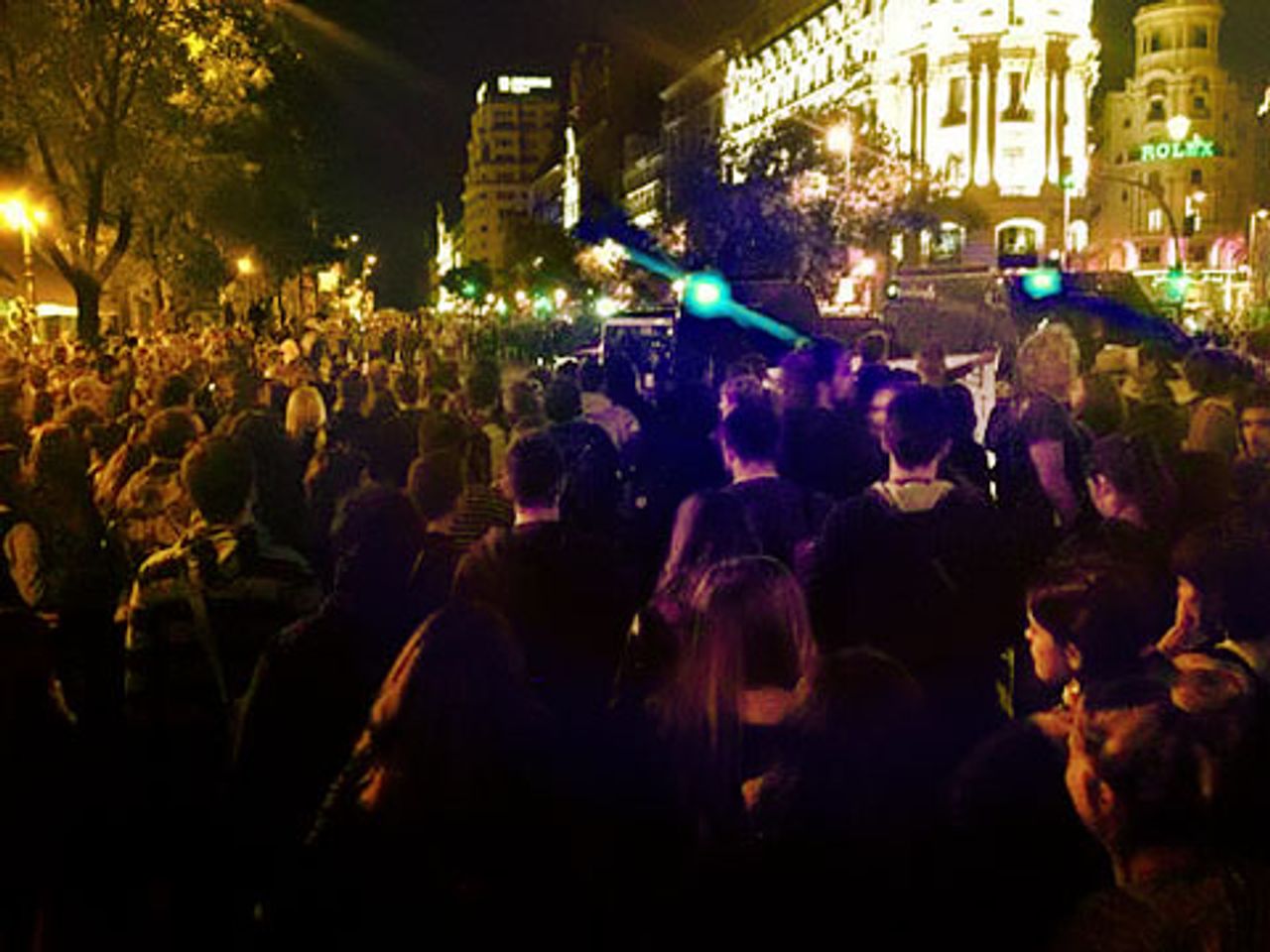 Demonstration in Madrid
Demonstration in MadridTens of thousands of demonstrators—far in excess of the 6,000 acknowledged by government sources—marched Tuesday to surround the Congress of Deputies, Spain’s parliament.
The demonstration was called through the social networks of Facebook, Twitter and others under the banner “Occupy Congress”.
Spanish police set up barriers in the adjacent streets to parliament four days before. They comprised three rings, the first situated 500 meters away from congress.
Days before, arrests were also made of those suspected of organizing the event. During a token protest in Madrid ten days before staged by the trade unions, police arrested people who had unfurled a banner inviting others to join the September 25 march. They were arrested under the charge of “resistance to authority.”
On September 25, the Government Delegate of Madrid mobilized 1,400 police of the special anti-riot squad, the hated Unidades de Internvención Policial (Police Intervention Units—UIP).
The demonstration went peacefully before the police charged.
Tens of thousands with homemade banners had massed in one of Madrid’s main squares, Plaza de Neptuno, for the march on parliament. Their route towards the congress main entrance was blocked off by metal railings, police vans and hundreds of Spanish riot police.
Once they were near the parliament and they could advance no further, they started chanting, "Get out! Get out! They don't represent us!”, “Resign, resign”, “Revolt, revolt”, and “We are not criminals.”
Tension grew when eight police vans arrived and provocatively passed through the middle of the main demonstration. It was when a small group tried to break the security circle that the police responded violently, firing rubber bullets and baton-charging the demonstrators. Sixty-four protesters were injured, 16 of whom had to be taken to hospital. Thirty-eight people were arrested.
“The heavy-handed tactics of the Spanish police [were carried out], with little provocation,” the BBC acknowledged.
The attack was planned well in advance. For weeks, government officials had been threatening potential protestors not to go to the demonstration and promising police reprisals.
The Popular Party government delegate for Madrid, Cristina Cifuentes, said that the demonstration was organized by people “linked with fascism.” She added that any attempt to “coerce” the will of the deputies in congress would be “a crime … for this reason the police will act … in order to prevent any legislators from being pressured by external groups.”
Justice Minister Alberto Ruiz-Gallardon, stated that the protests are “a threat to our democratic system.”
María Dolores de Cospedal García, President of Castile-La Mancha and Secretary-General of the PP, compared the demonstration to the coup staged by Lieutenant Colonel Antonio Tejero in 1981, saying, “The last time I remember someone surrounding and taking congress was with the coup.”
All three are political heirs of General Franco’s National Movement, the main party of government for nearly 40 years that was installed after a coup in 1936 which led to a civil war, and from which the PP emerged.
All those arrested have been sent to the National Court, the highest court in Spain, accused of using violence against the parliament, which can mean three to five years in prison.
The extreme violence used against a peaceful demonstration was cheered by the General Secretary of the United Police Trade Union, who stated on Twitter, “We don’t have identification badges [which they are legally required to wear], hit them and that’s it.”
The next day Minister of Interior Jorge Fernández Díaz justified the repression, saying that the demonstrators acted with “too much violence”.
The show of strength by the government and the state was meant to reassure the Spanish bourgeoisie and global investors of the government’s determination to impose savage austerity measures and face off popular anger.
Spain is currently in a double-dip recession that economists predict will see the economy shrink by about 1.6 percent this year and again in 2013.
The government is currently imposing one austerity measure after another in a bid to reduce the deficit to 4.5 percent of GDP in 2012. The figure is currently on 4.77, exceeding by far the target for this year.
These measures, along with the economic crisis, have led to unemployment rising to over 50 percent among youth.
At the same time, the Catalan regional government has announced snap elections on November 25, in order press for independence. One of the richest regions of Spain, the move came after the PP government rejected a fiscal pact that would give the region more autonomy.
On the same day as the demonstration, Spain sold $5.14 billion in short-term debt, but at a higher cost than it paid at a similar auction a month ago. This is a sign that investors are concerned that the country might not be able to impose the austerity measures as promised.
A similar situation is developing in Portugal. Portuguese Prime Minister Pedro Passos Coelho agreed to cancel a social security tax rise planned to raise contributions next year from 11 percent to 18 percent after huge anti-austerity protests, again called through the social networks, erupted last week.
The government will present a new package of austerity measures today, when it unveils a draft budget for 2013, including pension freezes, spending cuts and tax increases.
